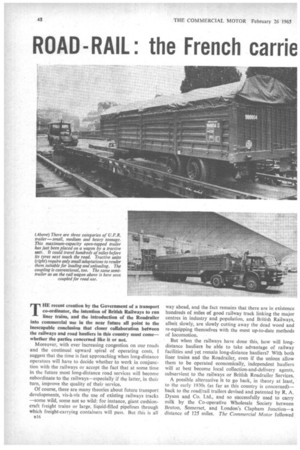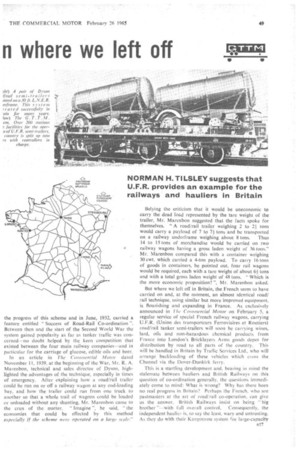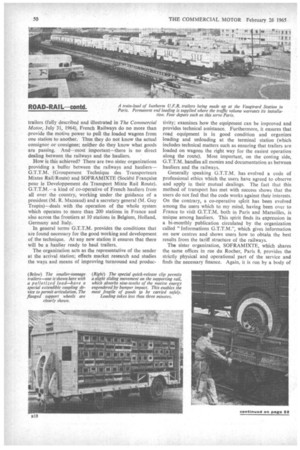ROAD-RAIL: the French carrie n where we left off
Page 50

Page 51

Page 52

Page 57

If you've noticed an error in this article please click here to report it so we can fix it.
THE recent creation by the Government of a transport co-ordinator, the intention of British Railways to run liner trains, and the introduction of the Roadrailer into commercial use in the near future all point to the inescapable conclusion that closer collaboration between the railways and road hauliers in this country must come— whether the parties concerned like it or not.
Moreover, with ever increasing congestion on our roads and the continual upward spiral of operating costs, 1 suggest that the time is fast approaching when long-distance operators will have to decide whether to work in conjunction with the railways or accept the fact that at some time in the future most long-distance road services will become subordinate to the railways—especially if the latter, in their turn, improve the quality of their service.
Of course, there are many theories about future transport developments, vis-à-vis the use of existing railways tracks —some wild, some not so wild: for instance, giant cushioncraft freight trains or large, liquid-filled pipelines through which freight-carrying containers will pass. But this is all
al6
way ahead, and the fact remains that there are in existence hundreds of miles of good railway track linking the major centres in industry and population, and British Railways, albeit slowly, are slowly cutting away the dead wood and re-equipping themselves with the most up-to-date methods of locomotion.
But when the railways have done this, how will longdistance hauliers be able to take advantage of railway facilities and yet remain long-distance hauliers? With both liner trains and the Roadrailer, even if the unions allow them to be operated economically, independent hauliers will at best become local collection-and-delivery agents, subservient to the railways or British Roadrailer Services., A possible alternative is to go back, in theory at least, to the early 1930s (as far as this country is concerned)— back to the road/rail trailers devised and patented by R. A. Dyson and Co. Ltd., and so successfully used to carry milk by the Co-operative Wholesale Society between Bruton, Somerset, and London's Clapham Junction—a distance of 125 miles. The Commercial Motor followed
the progress of this scheme and in June, 1932, carried a feature entitled "Success of Road-Rail Co-ordination ", Between then and the start of the Second World War the system gained popularity as far as tanker traffic was concerned—no doubt helped by the keen competition that existed between the four main railway companies—and in particular for the carriage of glucose, edible Oils and beer.
In an article in The Commercial Motor dated November 11, 039, at the beginning of the War, Mr. R. A. Marenbon, technical and sales director of Dyson, highlighted the advantages of the technique, especially in times of emergency. After explaining how a road/rail trailer could be run on or off a railway wagon at any end-loading bay, and how the trailer could run from one truck to another so that a whole trail of wagons could be loaded or unloaded without any shuffling, Mr. Marenbon came to the crux of the matter. " Imagine ", he said, " the economies that could be effected by this method .especially if the scheme were operated on a large scale."
Belying the criticism that it would be uneconomic to carry the dead load represented by the tare weight of the trailer, Mr. Marenbon suggested that the facts spoke for themselves. " A road/rail trailer weighing 2 to 2+ tons would carry a payload of 7 to 7+ tons and be transported
on a railway underframe weighing about 8 tons. Thus 14 to 15 tons of merchandise would be carried on two railway wagons having a gross laden weight of 36 tons." Mr. Marenbon compared this with a container weighing 30-cwt. which carried a 4-ton payload. To carry 16 tons of goods in containers, he pointed out, four rail wagons would be required, each with a tare weight of about 61 tons and with a total gross laden weight of 48 tons. "Which is the more economic proposition?", Mr. Marenbon asked.
But where we left off in Britain, the French seem to have carried on and, at the moment, an almost identical road/ rail technique, using similar but more improved equipment, is flourishing and expanding in France. As exclusively announced in 7he Commercial Motor on February 5, a regular service of special French railway wagons, carrying U.F.R. (Union des transporteurs Ferroviaires et Routiers) road/rail tanker semi-trailers will soon be carrying wines, lard, oils and non-hazardous chemical products from France into London's Bricklayers Arms goods depot for distribution by road to all parts of the country. This will be handled in Britain by Traffic Services Ltd., who will arrange backloading of these vehicles which Cross the Channel via the Dover-Dunkirk ferry.
This is a startling development and, bearing in mind the stalemate between hauliers and British Railways on this question of co-ordination generally, the questions immediately come to mind: What is wrong? Why has there been no real progress in Britain? Perhaps the French, who are pastmasters at the art of road/rail co-operation, can give us the answer. British Railways insist on being " big brother "—with full ol..erall control. Consequently, the independent haulier is, to say the least, wary and untrusting. As they do with their Kangottrou system for large-capacity 1117
trailers (fully described and illustrated in The Commercial Motor, July 31, 1964), French Railways do no more than provide the motive power to pull the loaded wagons from one station to another. Thus they do not know the actual consignor or consignee; neither do they know what goods are passing. And—most important—there is no direct dealing between the railways and the hauliers.
How is this achieved? There are two sister organizations providing a buffer between the railways and hauliersG.T.T.M. (Groupement Technique des Transporteurs Mixtes Rail/Route) and SOFRAMIXTE (Societe Francaise pour le Developpement du Transport Mixte Rail Route). G.T.T.M .----a kind of co-operative of French hauliers from all over the country, working under the guidance of a president (M. R. Mazeaud) and a secretary general (M. Guy Tropin)—deals with the operation of the whole system which operates to more than 200 stations in France and also across the frontiers at 10 stations in Belgium, Holland, Germany and Italy.
in general terms G.T.T.M. provides the conditions that are found necessary for the good working and development of the technique. At any new station it ensures that there will be a haulier ready to haul trailers.
The organization acts as the representative of the sender at the arrival station; effects market research and studies the ways and means of improving turnround and produc tivity; examines how the equipment can be improved and provides technical assistance. Furthermore, it ensures that road equipment is in good condition and organizes loading and unloading at the terminal station (which includes technical matters such as ensuring that trailers are loaded on wagons the right way for the easiest operation along the route). Most important, on the costing side, G.T.T.M. handles all monies and documentation as between hauliers and the railways.
Generally speaking G.T.T.M. has evolved a code of professional ethics which the users have agreed to observe and apply in their mutual dealings. The fact that this method of transport has met with success shows that the users do not feel that the code works against their interests. On the contrary, a co-operative spirit has been evolved among the users which to my mind, having been over to France to visit G.T.T.M, both in Paris and Marseilles, is unique among hauliers. This spirit finds its expression in a bi-monthly publication circulated by the organization called "Informations G.T.T.M.", which gives information on new centres and shows users how to obtain the best results from the tariff structure of the railways.
The sister organization, SOFRAMIXTE, which shares the same offices in rue du Rocher, Paris 8, provides the strictly physical and operational part of the service and finds the necessary finance. Again, it is run by a body of hauliers under the presidency of M. C. Montreuil, director of a large haulage concern in Chambery; M. Mazeaud is director general and M. Tropin is secretary general.
SOFRAMIXTE deals with the actual rolling stock—both road and rail. It sells and maintains the semi-trailers, which are built by a number of French firms, and secures the after-sales service and supplies parts. It is responsible for the financial running of the rail wagons (those it owns and those hired from the railways) and possesses a fleet of trailers which are hired out to users during peak periods.
By far the most interesting aspect of this whole operation is the fact that French Railways makes a grant to the operator of about a third of the cost of the equipment. To obtain this hauliers have to sign a 10or •15-year contract (shorter contracts will be available soon, I gather) that they will use the system. The haulier agrees, in the contract, to send a guaranteed amount of freight during that period, for which he receives a preferential tariff from the railways. By signing the contract he undertakes not to use the trailer for road journeys farther than a radius of 50 miles from his base.
The first U.F.R. semi-trailers were built in France in 1935. The French themselves describe it as "the French solution to a problem already examined in England, in particular by Dyson of Liverpool ". However, it was not until after the last War that the method became widely used in France. U.F.R. semi-trailers are classified under three categories—small, medium and heavy tonnage. They are constructed to fit within the normal loading gauge of the Continental European Railways when loaded on adapted flat wagons of ordinary basic construction.
Special features of the trailers are an auxiliary flanged pair of wheels at the front to support the forepart of the trailers when on the wagon, and steel-flanged rear wheels which support the weight of the rear of the trailer when on the wagon. For the smaller trailers (those that will come to Britain) not exceeding 15 tons gross—there is a collapsible device for coupling. Various kinds of trailers are availabie—boxvans, flats, refrigerated vans, open-topped vehicles and tankers. They can be constructed to TIR specifications if required.
At stations where the volume of traffic is heavy, a fixed loading ramp is used; but where use does not merit this, a portable loading bridge is supplied.
French Railways have created a special tariff for the running of this traffic, a special feature of which is that the rate is calculated only in relation to weight and distance No account is taken of the nature of the goods.
The success of this system—harking back to Mr. Marinbon's words in 1939—is because it has been carried out on a large scale. G.T.T.M. offers a service at more than 200 stations in France, with no less than four depots in Paris, serving the various regions. More than 2,500 trailers are operated by SOFRAMIXTE. Among this total there are no less than 350 small tankers of the type that will be seen in Britain soon. An indication of how the system has gained popularity may be gained from these simple figures. In 1946, when G.T.T.M. came into being, there were only 25 trailers, which carried a mere 50,000 tons of goods between nine stations. In 1963 there were 2,500 trailers, which carried approximately 1,000,000 tons between 200 stations. During peak periods some stations handle
more than 5,000 trailers per month. Dealing with such , numbers, French Railways are able to operate special goods trains hauling U.F.R. and Kangourou trailers on a regular timetable basis.
Visiting France last month I was able to see a U.F.R. semi-trailer van being loaded with paint at Le Bourget, near Paris, at 4 p.m. The destination was Marseilles. After the vehicle was sealed it was towed into the Ivry depot of G.T.T.M. in Paris, where it took precisely three minutes to back the trailer on to the wagon and securely clip it. Meanwhile, the paperwork was being completed in the organization's office—which resembles an airport control tower—at the site. Invoices were made out by special machines and Marseilles informed of the movement, the number of the trailer, and so on, by telex.
next saw the vehicle arriving at the Marseilles St. Charles railway depot, more than 500 miles away on the Mediterranean coast, at 9 a.m. the next day. After being shunted into a special siding allotted to road/rail traffic, the trailer was offloaded in about four minutes. It was not delivered that day because, it being a Saturday, the factory was closed; but this is as fine an example of road/ rail co-operation as can be found in Europe.
This technique enables trailers to traverse vast distances in the minimum of time and with the minimum amount of congestion and consequent inconvenience to other road users. The 500-odd miles was achieved without the tyres touching the ground! The traffic, moreover, remained the haulier's throughout, and there was no direct contact between the two.
Is this the answer to road and rail co-ordination in this country?




















































































































